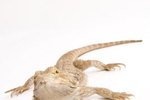
Vitamin D is unique in that it is the only vitamin that can come from a non-food source, namely sunshine. It is essential for bone growth, regulating the calcium and phosphorus content of bones, and for cell communication. However, not all animals are able to get vitamin D from sunshine. This is due either to their physical makeup or the environment in which they live.
Never See the Sun
Fish don’t get vitamin D from the sun. Bottom-dwelling and deep sea fish have no need for synthesizing sunlight into vitamin D, because they are never exposed to the sun. While other fish benefit hugely from UV light and use plasma to process it, this is not where they get their vitamin D. Fish get vitamin D from food, such as plankton, and store it in their livers. Fish actually are a great source of dietary vitamin D for other animals.
Domestic Reptiles
Reptiles rely heavily on vitamin D. In fact, many reptiles simply cannot function without first basking in the sunlight to warm up and would die if prevented from seeing sunlight. However, inexperienced reptile keepers may inadvertently deny their pets vitamin D by not providing UV lamps. Mistakenly believing that their pets can get vitamin D when placed near a window, these pet owners simply are allowing their reptiles to warm up, as the vitamin D-containing UV cannot pass through glass or plastic.
The Effect of Fur
Fur covering the skin of an animal, much like clothing covering the skin of a human, limits the amount of vitamin D absorbed from sunlight. A study on cows conducted at Aarhus University in Denmark found that cows with less fur coverage on the body had more vitamin D-producing plasma after exposure to the sun, suggesting that animals with fur-covered bodies were less capable and less likely to synthesize a sufficient amount of the vitamin from sun exposure.
Ingesting Sunlight Vitamin D
Grass and hay is a good vitamin D source, but furry and feathered creatures have another way of getting their vitamin D. Although their coverage prevents them from absorbing the UV vitamin D directly, the act of grooming, namely the plucking of feathers and licking of fur, transfers small quantities of vitamin D stored externally into the digestive system, enabling the animals to process vitamin D internally.
References
- Medical News Today: What is Vitamin D?
- Wet Web Media: The Ultimate Aquarium? An Angelfish Community Tank!
- Pubmed: The Evolution and Function of Vitamin D
- University of Illinois at Urbana-Champaign; Vetmed -- Pet Reptiles Need Vitamin D and Calcium for Bone Health
- Pubmed: Vitamin D(3) Synthesis in the Entire Skin Surface of Dairy Cows Despite Hair Coverage
- Green Pasture: Vitamin D Metabolism in Fish-Part 1
- Cambridge Journals: The Vitamin D Activity of Pastures and Hays
- Solar C Systems: Vitamin D Phototherapy Frequently Asked Questions (FAQ)
Photo Credits
-
Hemera Technologies/Photos.com/Getty Images
Writer Bio
Simon Foden has been a freelance writer and editor since 1999. He began his writing career after graduating with a Bachelors of Arts degree in music from Salford University. He has contributed to and written for various magazines including "K9 Magazine" and "Pet Friendly Magazine." He has also written for Dogmagazine.net.



